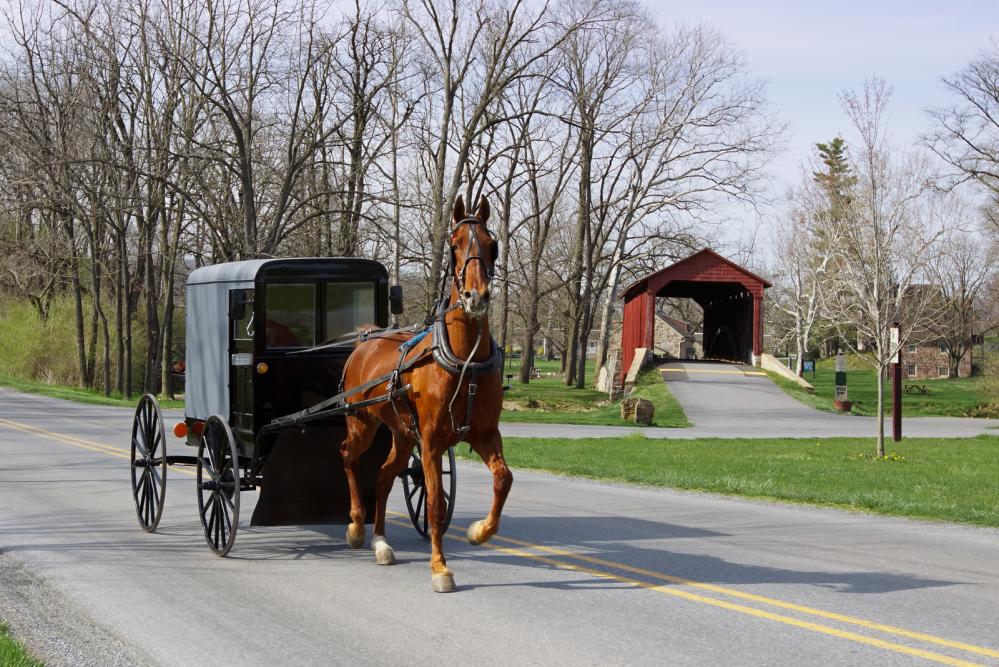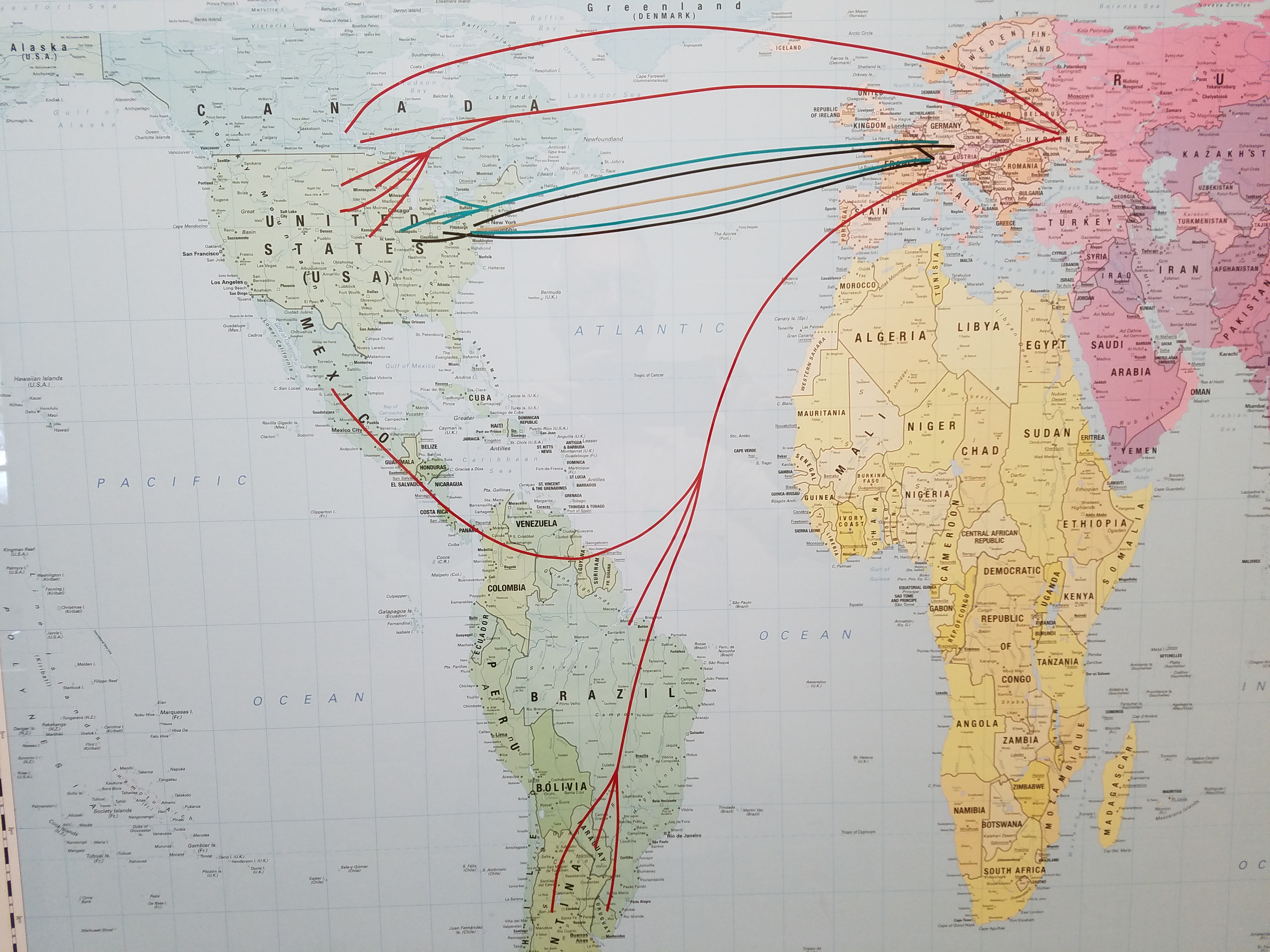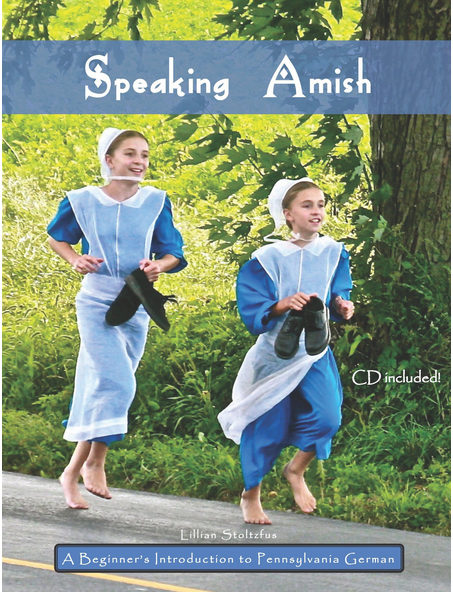Discovering Pennsylvania Dutch with “Speaking Amish”
 Recently, after attending a family wedding in Virginia, we drove back to Boston via Pennsylvania Dutch country.
Recently, after attending a family wedding in Virginia, we drove back to Boston via Pennsylvania Dutch country.
We knew that the Amish and many Mennonites speak German dialects, but otherwise knew little about the history and language of these group.
(If you read our posts about Northern Germany, or Seville Spain, you know that we enjoy learning about dialects.)
Yes, we also saw several of the black Amish buggies (see picture), but we wanted to look especially into the language angle.
Passing through Lancaster county, we stopped off at the Mennonite Information Center to learn about the Pennsylvania Dutch language (also known as Pennsylvania German).
At the Center, we saw a film about the history and culture of the Amish, and we bought a book "Speaking Amish" - A Beginner's Introduction to Pennsylvania German, by Lillian Stoltzfus, which I'll review briefly below.
In her introduction, Stoltzfus explains: "Pennsylvania German is spoken throughout the United States and Canada. Although people from each region can understand each other, each region speaks it a little differently."
What surprised us was to learn that most Pennsylvania Dutch speakers are ethnically Swiss.
A Little History: Why Swiss?
2017 is the year that Protestants are celebrating the 500th anniversary of Luther posting his 95 Theses in Wittenberg, Germany.
It was in Switzerland that the Anabaptist movement originally began in the 1520s, as a radical offshoot of Ulrich Zwingli's Reformation in Switzerland. The movement slowly spread through western Europe.
In Switzerland, the Anabaptists were persecuted for their beliefs. Many fled to the Palatinate, a region in the southwest of Germany. The Palatinate (historically, "die Rheinpfalz") lies west of the state of Hessen and northwest of Baden-Württemberg.
As time went on, Anabaptist followers pickedup the name "Mennonite" after Menno Simons,"  a Friesian religious leader, who was active as a religious leader from 1537 to 1561. The "Amish" were named after Jakob Ammann, a Swiss leader of the Anabaptist movement from 1680 to 1712.
a Friesian religious leader, who was active as a religious leader from 1537 to 1561. The "Amish" were named after Jakob Ammann, a Swiss leader of the Anabaptist movement from 1680 to 1712.
From the late 1640s on, numerous Anabaptist families (who first called themselves "Swiss Bretheren") arrived in Pennsylvania as a result of William Penn's experiment in religious tolerance. Amish and Mennonite families followed in the early 1700s.
A large number of Anabaptist followers came from the Palatinate (to where the Swiss had fled), and a smaller number from Alsace and Switzerland.
The map above from the Mennonite Information Center shows the migration of the Amish and Mennonites through the centuries. (Black lines: Amish to Pennsylvania, Indiana, Ohio and Illinois, other colors: Mennonites' migrations.)
The Palatinate Dialect
The German spoken in the Palatinate (i.e. "Pfälzisch") is the linguistic ancestor of the Pennsylviania Dutch dialect. Palatine German belongs to the West Franconian group or dialects.
Pennsylvania Dutch (i.e. Pennsylvania German) is the primary language of most Amish and conservative Mennonite communities living in the United States today.
Why Pennsylvania "Dutch"?
A possible explanation for the use of "Dutch" (to mean German) is that in the English of the 18th and 19th centuries, the term "Dutch" included what we now call Dutch, Flemish and German.
At that time, you distinguished between "High Dutch" (German) and "Low Dutch" (Dutch, Flemish). Germany did not become a country until 1871. There were only Hessians, Prussians, Bavarians, etc. , citizens of the many kingdoms and duchies that eventually became part of the German nation.
For English speakers they were all “Dutch"!
Quick Review of "Speaking Amish"
 Lillian Stoltzfus' book is a delightful introduction to Pennsylvania German and includes suggestions on how to best study.
Lillian Stoltzfus' book is a delightful introduction to Pennsylvania German and includes suggestions on how to best study.
The book is made up of 25 short lessons, each with five to ten new words that are shown together with a picture to help memorization. In the lessons you get clear and practical Phonetic, Grammar and Culture Tips.
There are also short exercises, with the answers given in the back. The audios for each lesson are between one and two minutes long and spoken naturally by two children and as well as Lillian Stoltzfus herself.
At the end of the book, there are several Verb Charts and a Phonetics Chart for reference.
The Pronunciation of Pennsylvania Dutch (PD)
Every dialect of a language has its characteristic pronunciation. The CD that comes with "Speaking Amish" is really helpful. But for me it's hard to describe pronunciation without audio.
Still, for anyone who knows some Standard German (SG), here are 3 characteristics of Pennsylvania Dutch (PD).
1) PD has no umlauts: no "ä", "ö", "ü", and also no "äu"/"eu".
To produce the equivalent sounds in PD, you "unround" your lips (pull them apart): For example:
• SG "dünn" - PD "dinn" (rhymes with "thin")
• SG "Löffel" - PD "Leffel" (vowel as in "left")
• SG "Deutsch" - PD "Deitsch" (vowel as in "hi")
2) In PD "ch" usually has a "sch" sound. For example:
• SG "ich" - PD "isch"
• SG "du bist" - PD "du bischt"
• SG "richtig" - PD "rischtisch"
3) Sounds at the end of a syllable or the end of words are often dropped. For example:
• SG "haben" - PD "hann"
• SG "Hunde" - PD "Hunn"
• SG "müde" - PD "miid"
Daily Vocabulary
The vocabulary lists below are all taken from "Speaking Amish". As Lillian Stoltzfus explains in her introduction, the words she teaches in the book are all from Pennsylvania German spoken in Lancaster county, or even more specifically from those spoken in her family.
Speakers from other regions in the U.S. or Canada, may have different words and various pronunciations.
Commonly used Nouns
Pennsylvania German uses three articles for "the":
• der (with masculine nouns), die (with feminine nouns, es (with neuter nouns)
• die Schprooch - SG "die Sprache" (the language/dialect)
• es Ess-sach - SG "das Essen" (the food)
• die Kich - SG "die Küche" (the kitchen)
• die Schtubb - SG "die Stube" (the room)
• der Gaarde - SG "der Garten" (the garden)
• die Arwet - SG "die Arbeit" (the work)
• der Nochber - SG "der Nachbar" (the neighbor)
• der Bu - SB "der Bub" (the boy)
• es Meedel - SB "das Mädel" (the girl)
die Gmee - SG "die Gemeinde" (the church)
Commonly used Verbs
Pennsylvania German has these pronouns that combine with personal verb forms:
• ich (I), du (you), er (he), sie (she), es (it), mir (we), dir (you pl.), sie (they)
• hawwe - SG "haben" (to have)
• gewwe - SG "geben" (to give)
• schreiwe - SG "schreiben" (to write)
• gleiche - SG "mögen" (to like)
• schaffe - SG "arbeiten" (to work)
• laafe - SG "laufen" (to walk)
• duh - SG "tun" (to do)
• hocke - SG "sitzen" (to sit)
• butze - SG "putzen" (to clean)
• wuhne - SG "wohnen" (to live)
Words similar to English
Not surprisingly, English words have become part of Pennsylvania Dutch:
• die Schtori - SG "die Geschichte" (the story)
• der Boi - SG "der (Obst)kuchen" (the pie)
• der Daett - SG "der Papa" (the dad)
• schmaert - SG "klug" (smart)
• die Dallbopp - SG "die Puppe" (the doll)
• der Pickder - SG "das Bild" (the picture)
die Gwilt - SG "die Steppdecke" (the quilt)
der Schtor - SG "der Laden" (the store)
Do Native Germans Understand Pennsylvania Dutch?
In Germany itself, there are a large number of dialects, and not every German speaker understands all of the other dialects of Germany really well. It generally depends on where a person is from and what experience with German dialects he or she has had.
Under the YouTube video: Lillian an Daniel Stoltzfus Lancaster County, which shows some interviews in Pennsylvania Dutch, there are a few of comments by native German speakers.
• "I am from the south-west of Germany and I understand the most. It is more the dialect of this part of Germany where I live.
(Ich komme aud dem Süd-Westen Deutschland und ich verstehe das meiste. Es ist mehr der Dialekt von diesem Teil Deutschlands wo ich wohne.)"
• "Sounds almost like Palatinate German mixed with American English. Many Pennsylvanian families come from the region here. So, it wouldn't surprise me.
[In Palatinate dialect]: (Klingt fascht wie Pälzisch mit Amerikanisches Englisch gemischt. Viele Pennslyfaanischi Familien kumme aus der Geschend hia. So es werd mich nit überrasche.)"
• "I speak German and Dutch fluently. I understand them perfectly as weird as it is, a funky old Swiss German accent mixed with yank English. None of it sounds Dutch."
Is Pennsylvania Dutch a "dying language"?
According to a SwissInfo article, it is estimated that there are about 300,000 to 350,000 speakers of Pennsylvania Dutch in 31 states of the U.S., mainly in Pennsylvania, Ohio, Indiana, and Wisconsin, and in Ontario, Canada.
There are also some Amish groups that speak Alsacian German and Swiss German (both Alemannic dialects). These number about 14,000 together.
Experts such as the German linguist Guido Seiler and Mark Loudon, a professor of German at Wisconsin-Madison, claim that the Pennsylvania Dutch and Alemannic German dialects spoken in the U.S. are anything but "dying languages".
In fact, the number of speakers is constantly increasing because of large families and because 90% of the youth stay in their traditional communities.
I have not touched on the religious differences between the Amish and various Mennonite groups. Those interested in finding out more can find ample information on the web or by contacting the Mennonite information Center.
"Shunning" is one of the differences. "The Shunning" is also the title of a book by Beverly Lewis and a 2011 movie.
Bio: Ulrike Rettig is the co-founder of GamesforLanguage.com. She is a lifelong language learner, growing up in Austria, the Netherlands, and Canada. You can follow her on Facebook, Twitter and Instagram, and leave any comments with contact or below.
